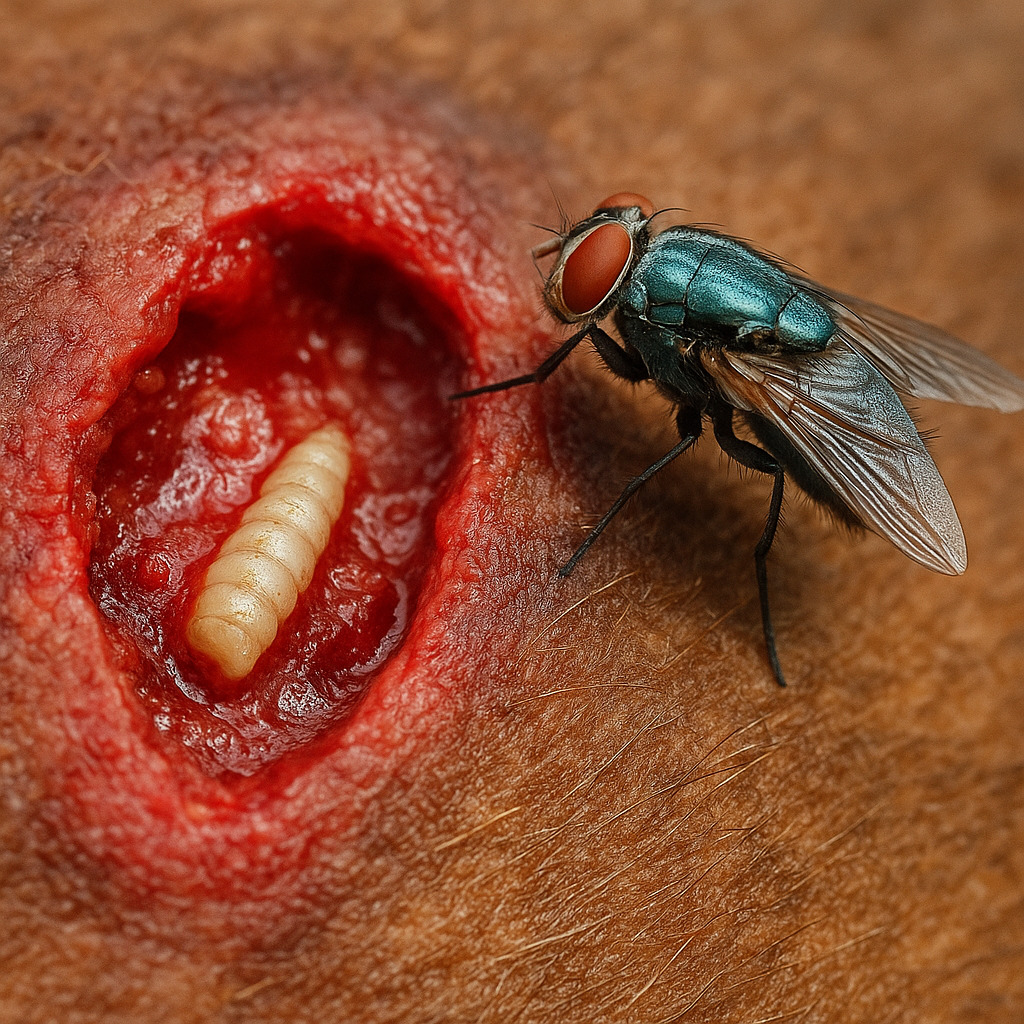Cochliomyia hominivorax: The Terrifying “Man-Eating” Larva
Nature is a fragile balance between life and death, and some of its most extreme manifestations seem to come straight out of a horror movie. Among them, Cochliomyia hominivorax, commonly known as the New World screwworm, stands out as a fearsome and incredibly effective parasite. While the nickname “man-eating larva” may sound exaggerated, it bluntly describes its horrifying ability to feed on living tissue, including that of humans.
😱 A Nightmarish Life Cycle
The life of Cochliomyia hominivorax begins as a seemingly ordinary fly. The nightmare unfolds when the fertilized female seeks an open wound on a warm-blooded animal. This could be a tiny abrasion, an insect bite, or a deeper lesion. Here she lays her eggs — anywhere from 10 to 400.
Within hours, the eggs hatch into voracious flesh-eating maggots. Cone-shaped and lined with rings of spines, the larvae burrow deep into the surrounding tissue. Their appetite is insatiable: they devour live flesh, necrotic tissue, blood, and lymph, progressively enlarging the wound and creating a gaping cavity.
The process inflicts excruciating pain on the host, turning into a relentless agony. After about 5–7 days, the mature larvae drop to the ground and pupate in the soil. Within a week, the adult fly emerges, ready to restart the horrifying cycle.
🐄 A Historical Plague and a Scientific Triumph
Historically, Cochliomyia hominivorax was a devastating plague for livestock throughout the Americas, causing massive economic losses. Infestations, known as myiasis, could also affect wild animals and, more rarely, humans. The consequences could be fatal, leading to secondary infections and septicemia.
Fortunately, science developed a powerful weapon to counter this dreadful threat: the Sterile Insect Technique (SIT). Developed in the 1950s by entomologist Edward F. Knipling, this revolutionary method involved releasing huge numbers of sterilized male flies.
When these sterile males mated with wild females, the resulting eggs were infertile. Since the female screwworm fly mates only once in her lifetime, the impact on the population was devastating. The life cycle was broken, leading to a rapid and drastic decline in numbers.
Thanks to this strategy, Cochliomyia hominivorax was successfully eradicated from the United States, Mexico, and much of Central and South America. It was a landmark scientific victory against one of the most terrifying parasites known.
🚨 Why Vigilance Is Still Needed
Despite these successes, the threat has not completely disappeared. The New World screwworm remains endemic in parts of South America, and in recent years new outbreaks have been reported in Central America and Mexico.
This has raised alarms in the United States, which already faced an outbreak in the Florida Keys in 2016, later eradicated. Today, the risk of reintroduction into the U.S. is considered real.
To counter this, the U.S. government has:
- Suspended live animal imports from Mexico.
- Strengthened surveillance at the southern border.
- Invested millions in new sterilization facilities to mass-produce sterile flies, ready to be released if necessary.
The story of Cochliomyia hominivorax is a striking reminder of how ruthless nature can be, but also how human ingenuity can prevail. The “man-eating larva” is no longer a widespread threat, yet recent alarms remind us that only knowledge, prevention, and constant surveillance can stop the return of this biological nightmare.








Leave a Comment